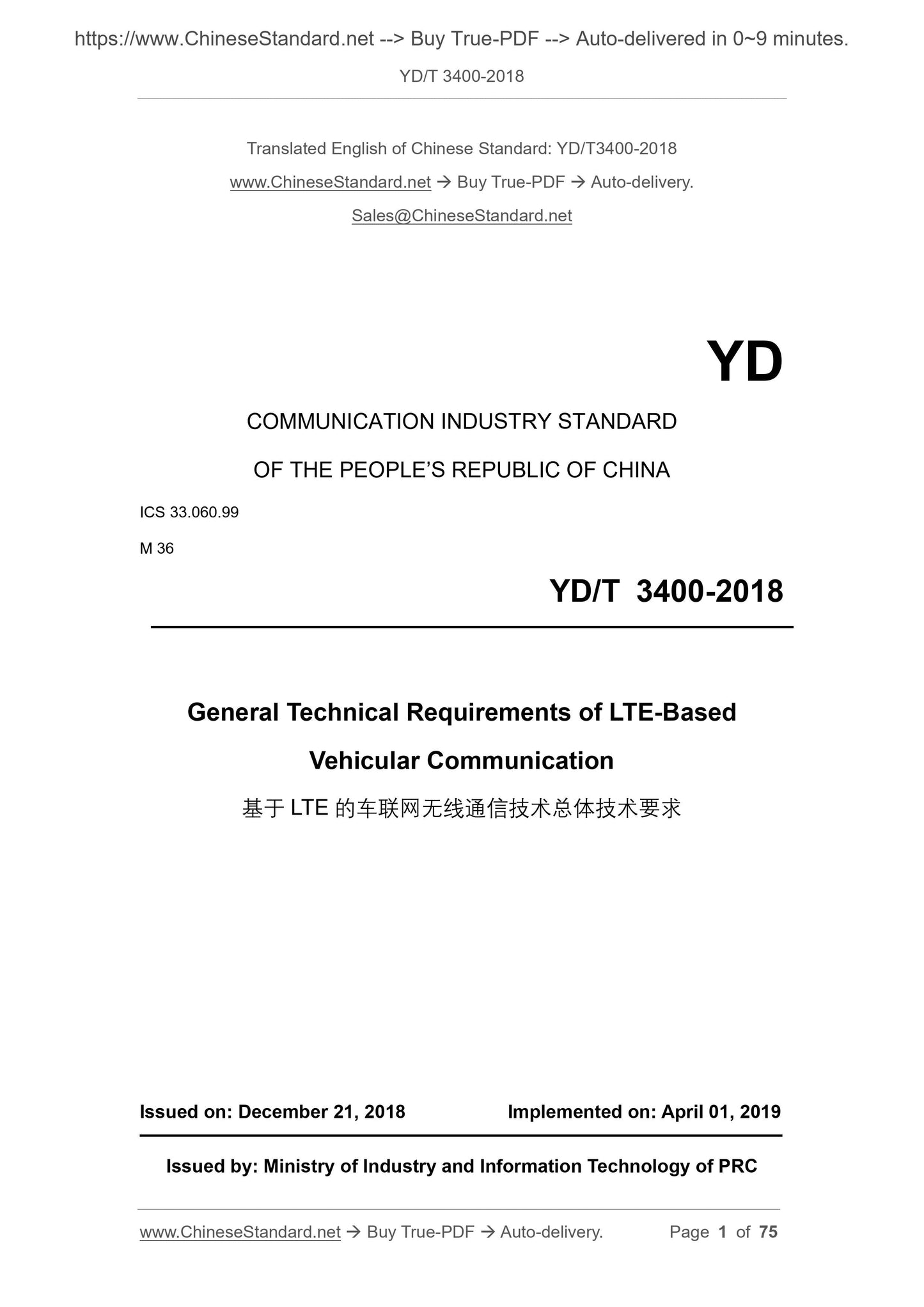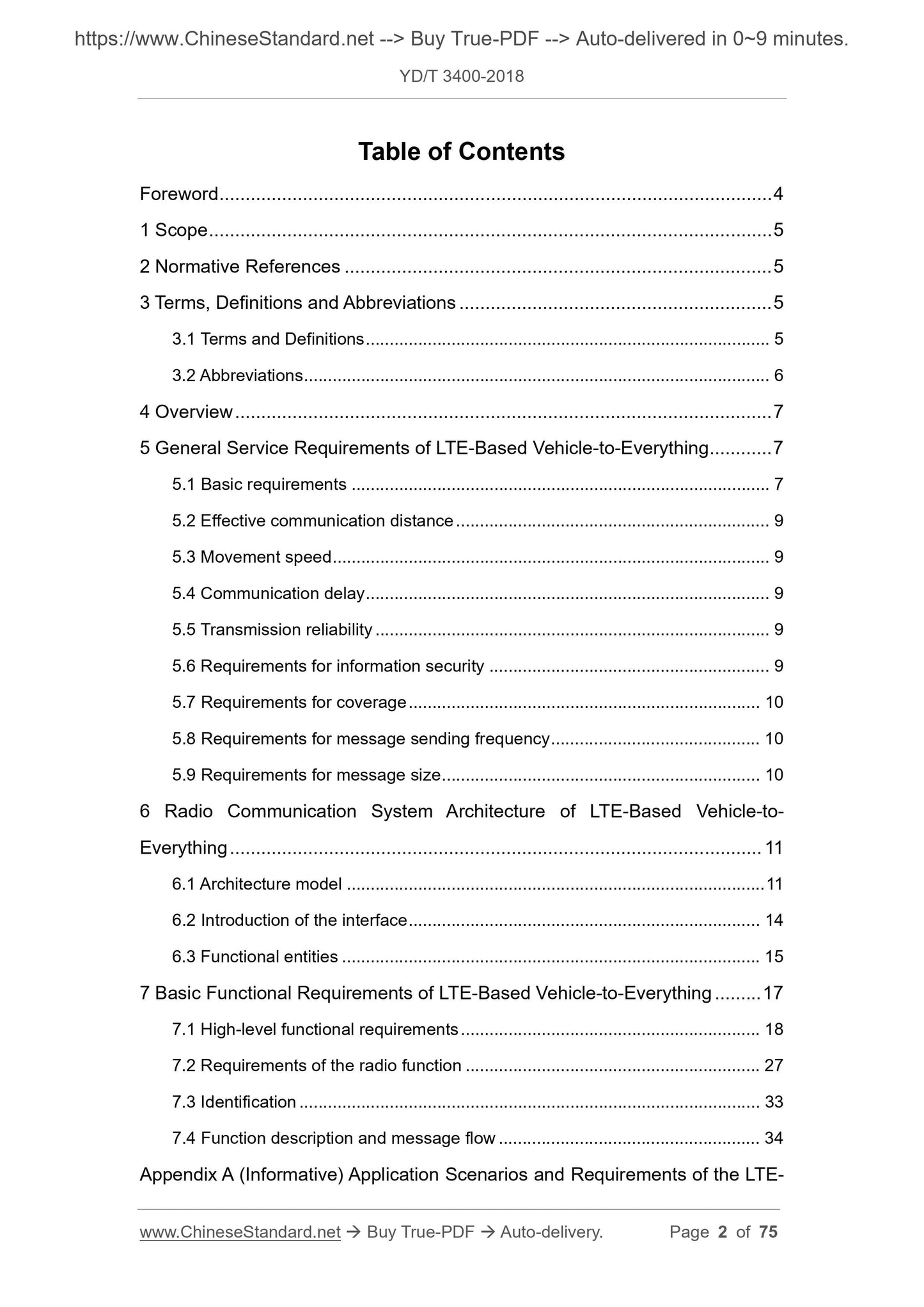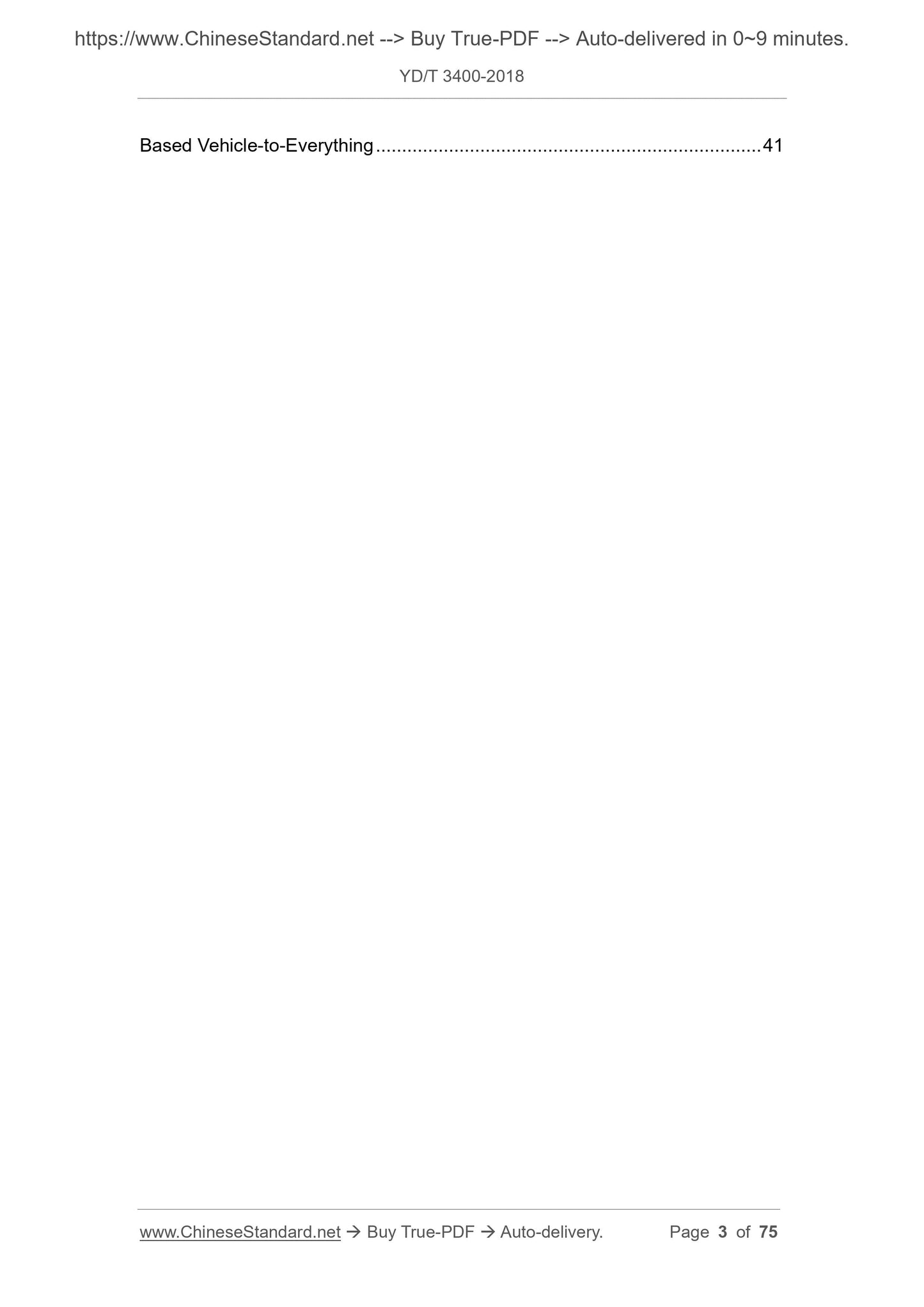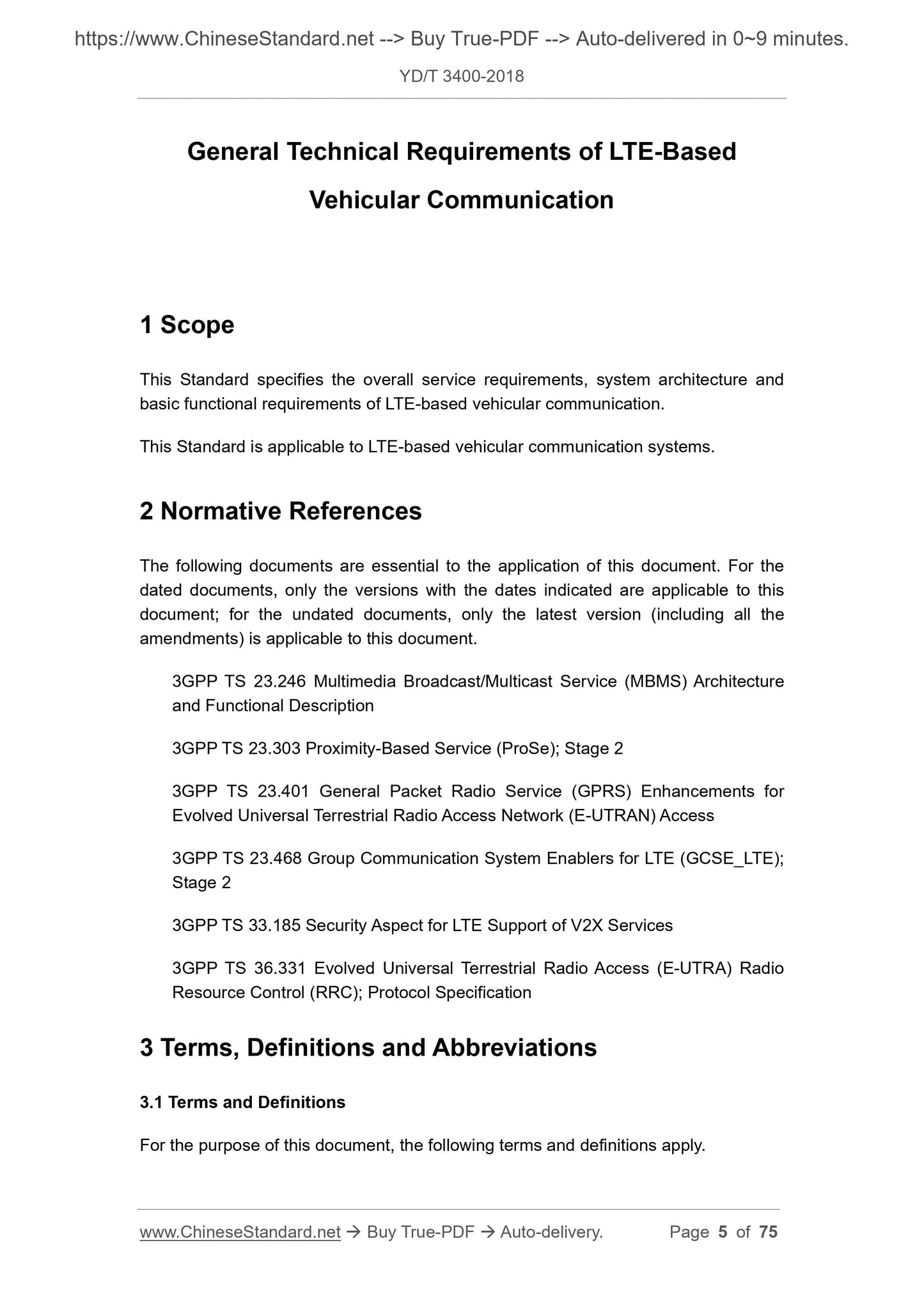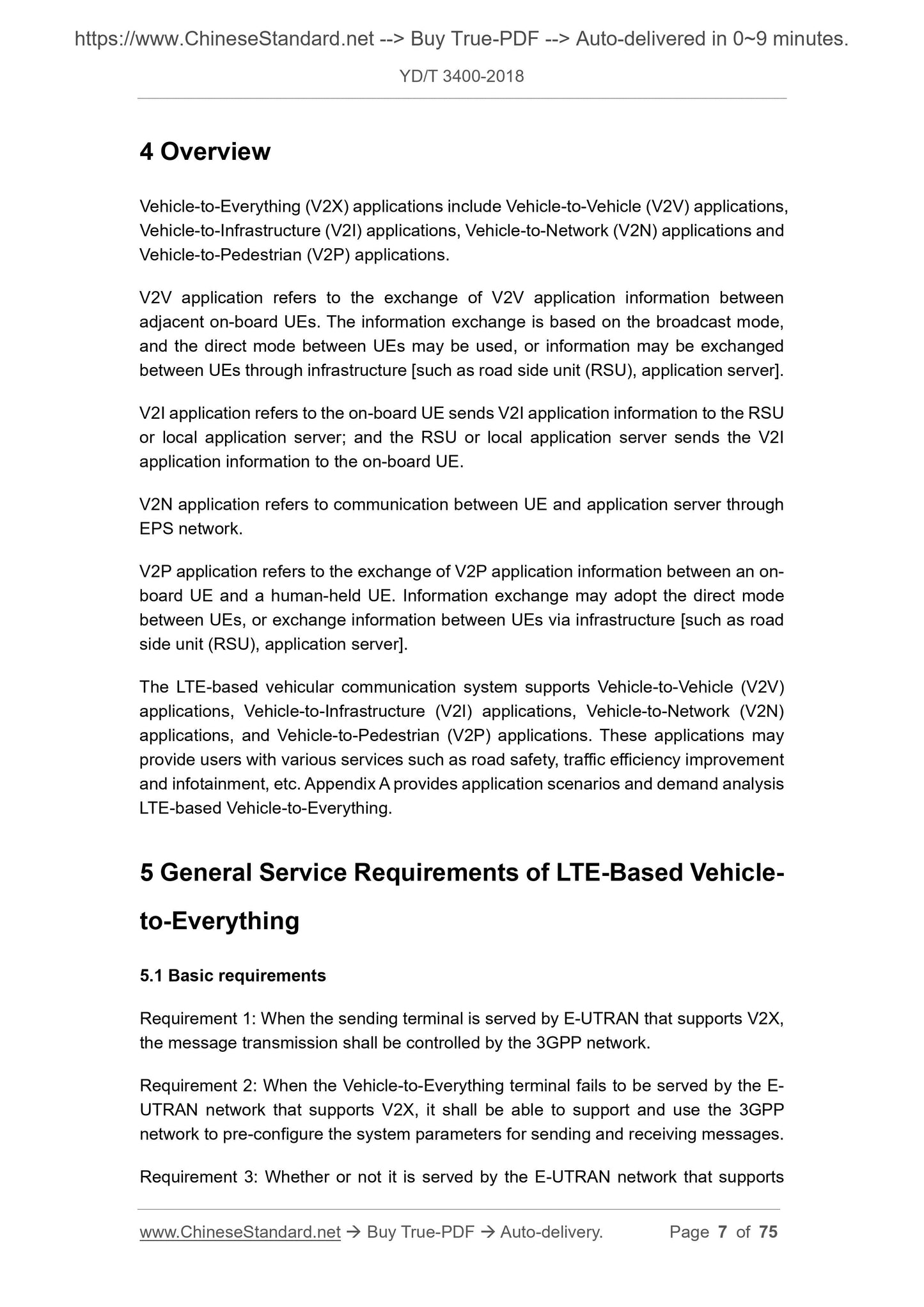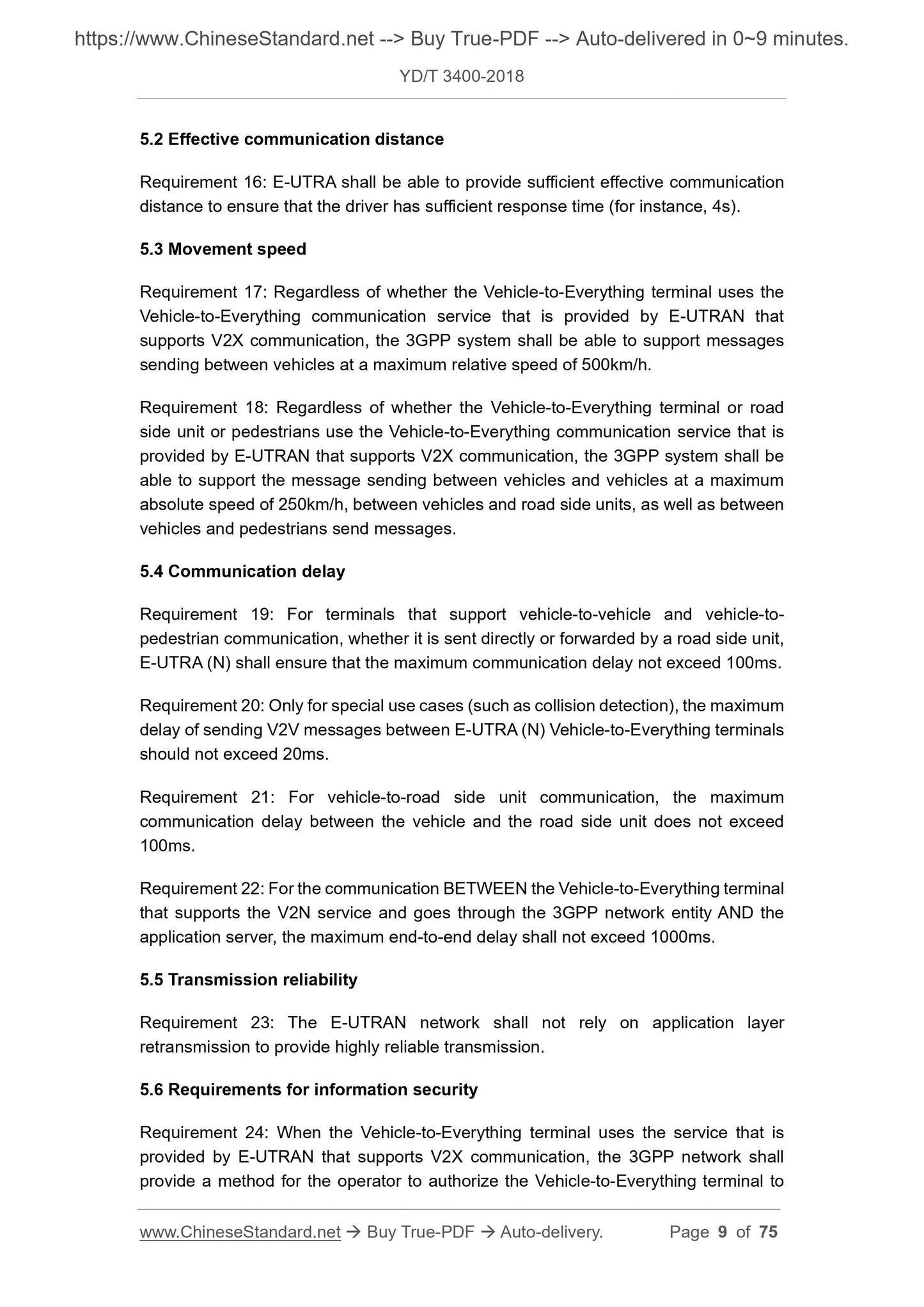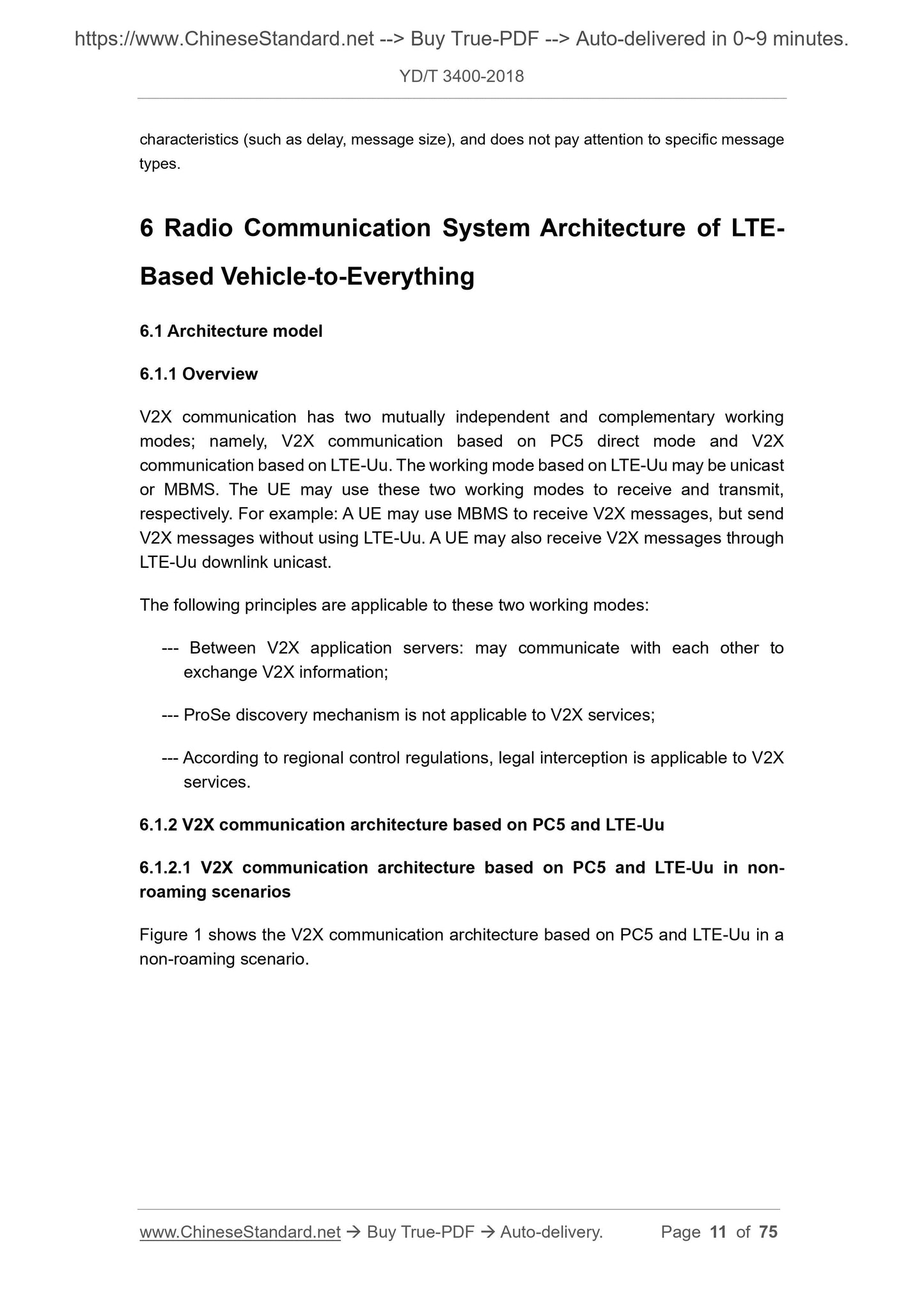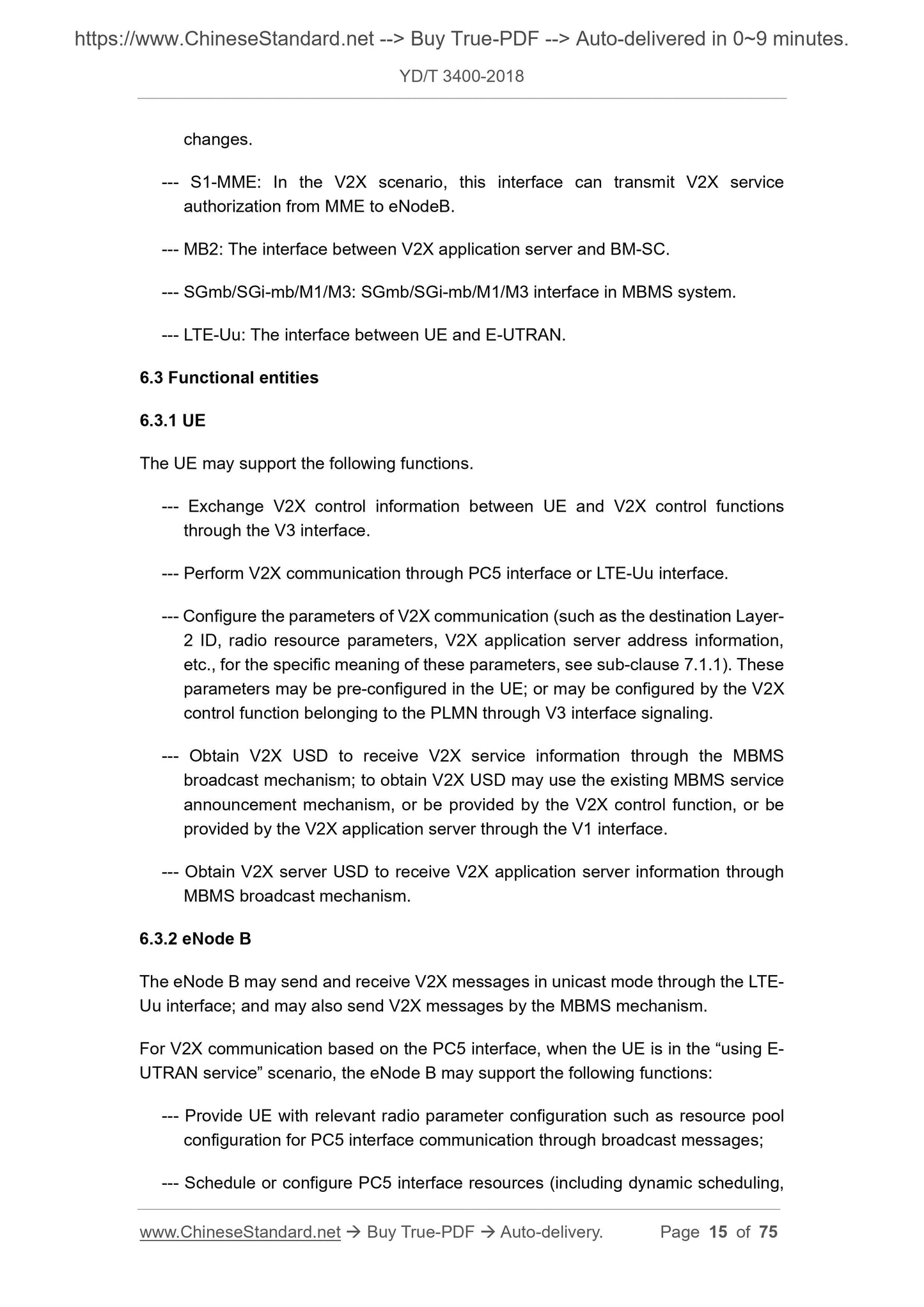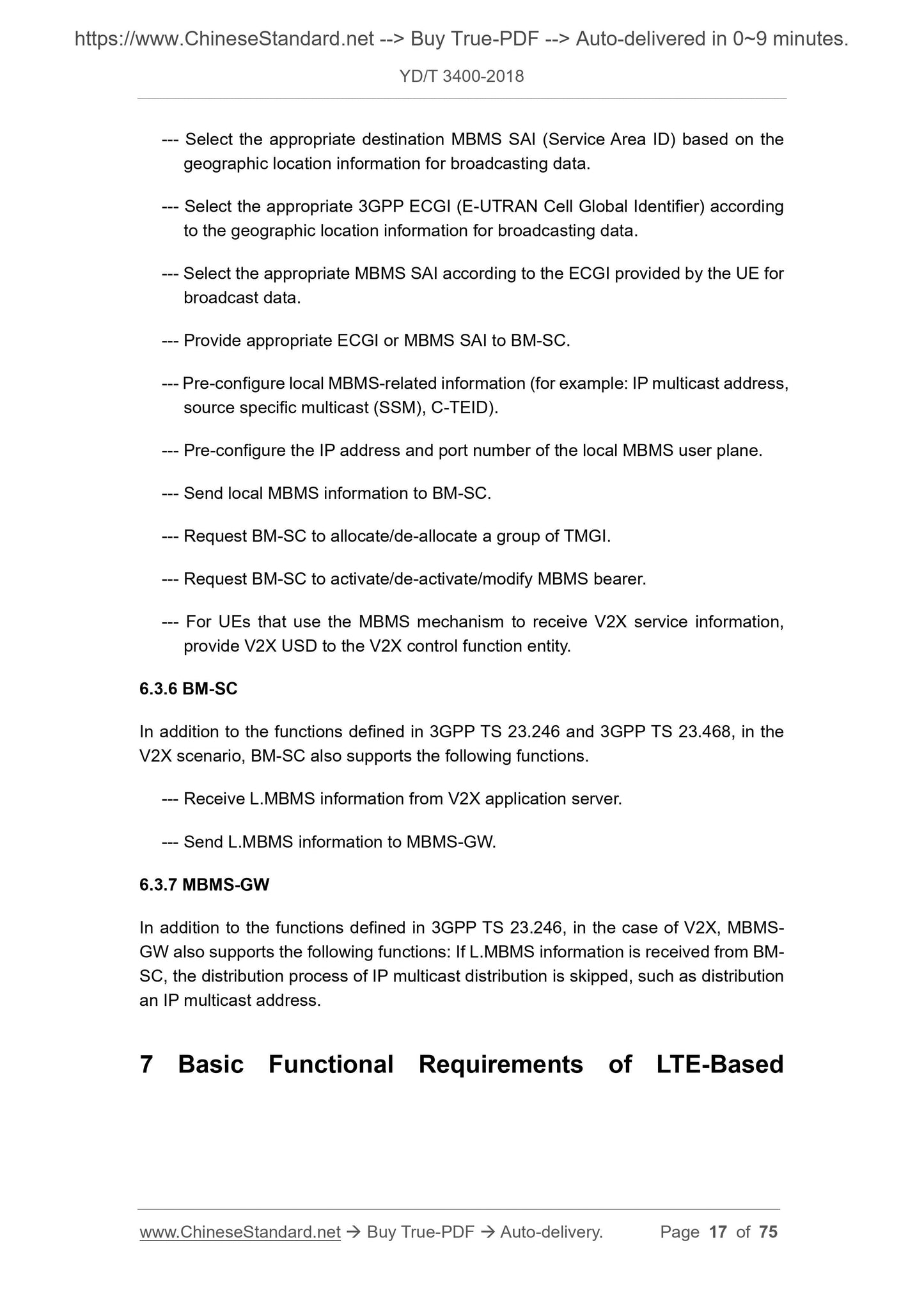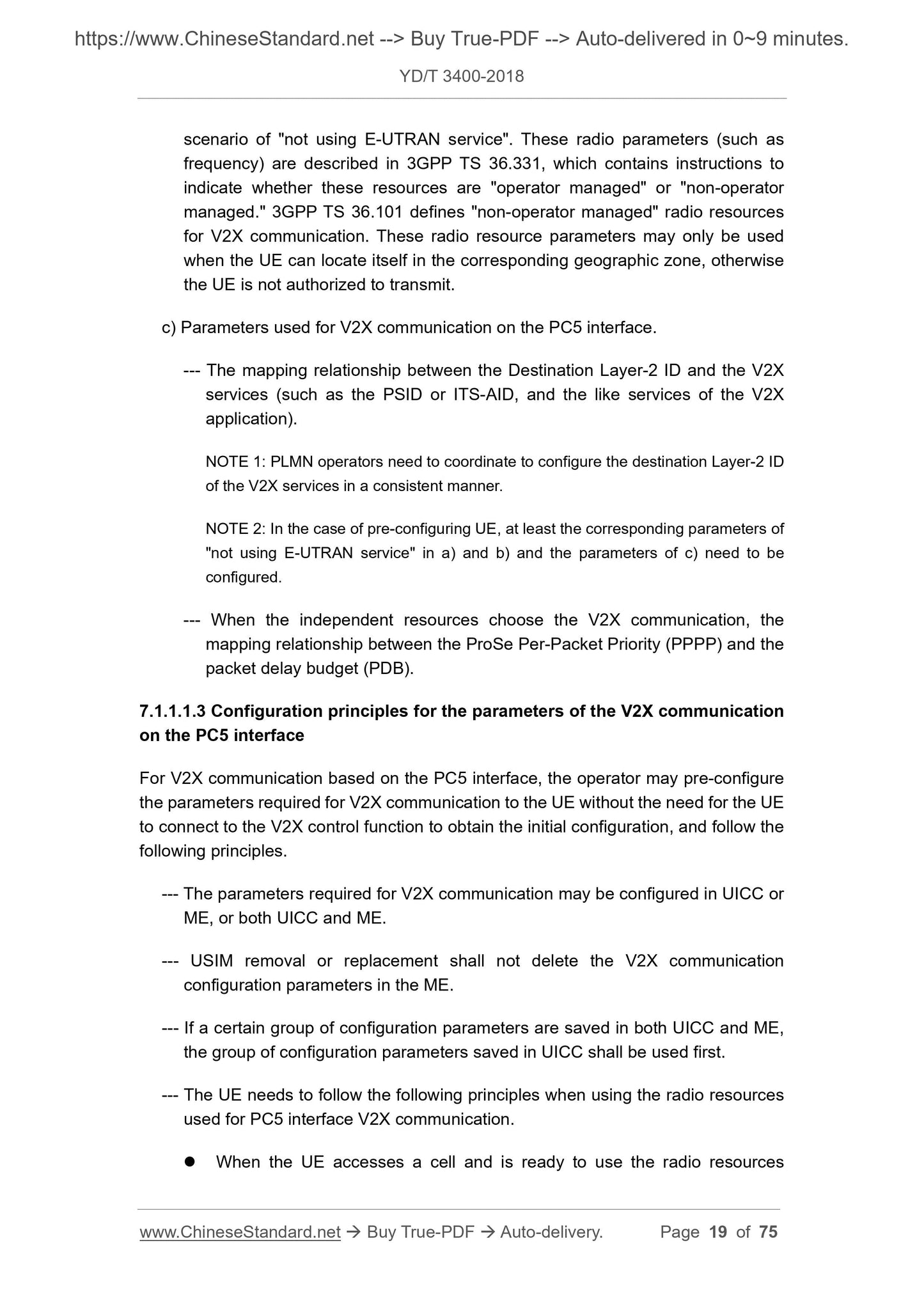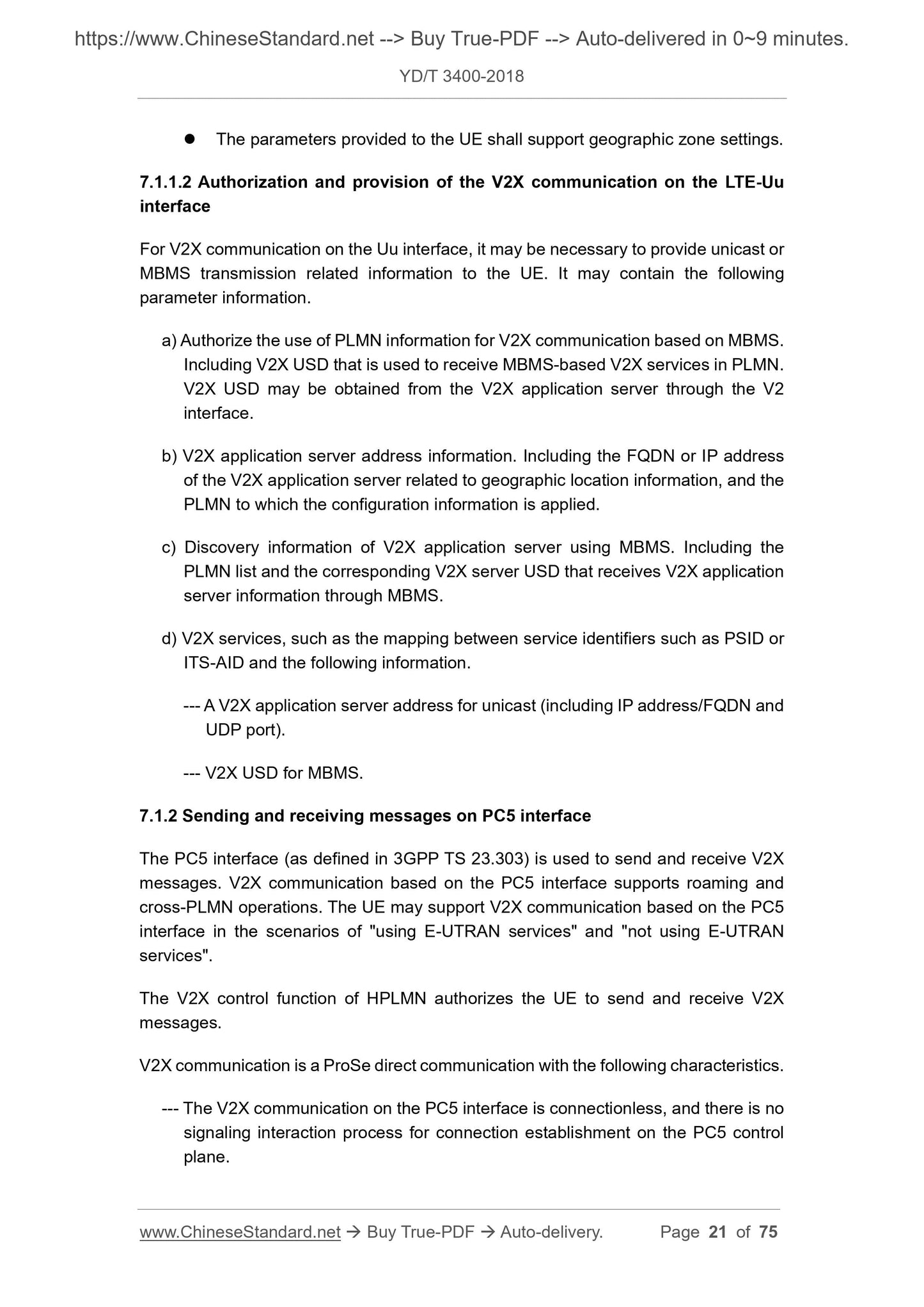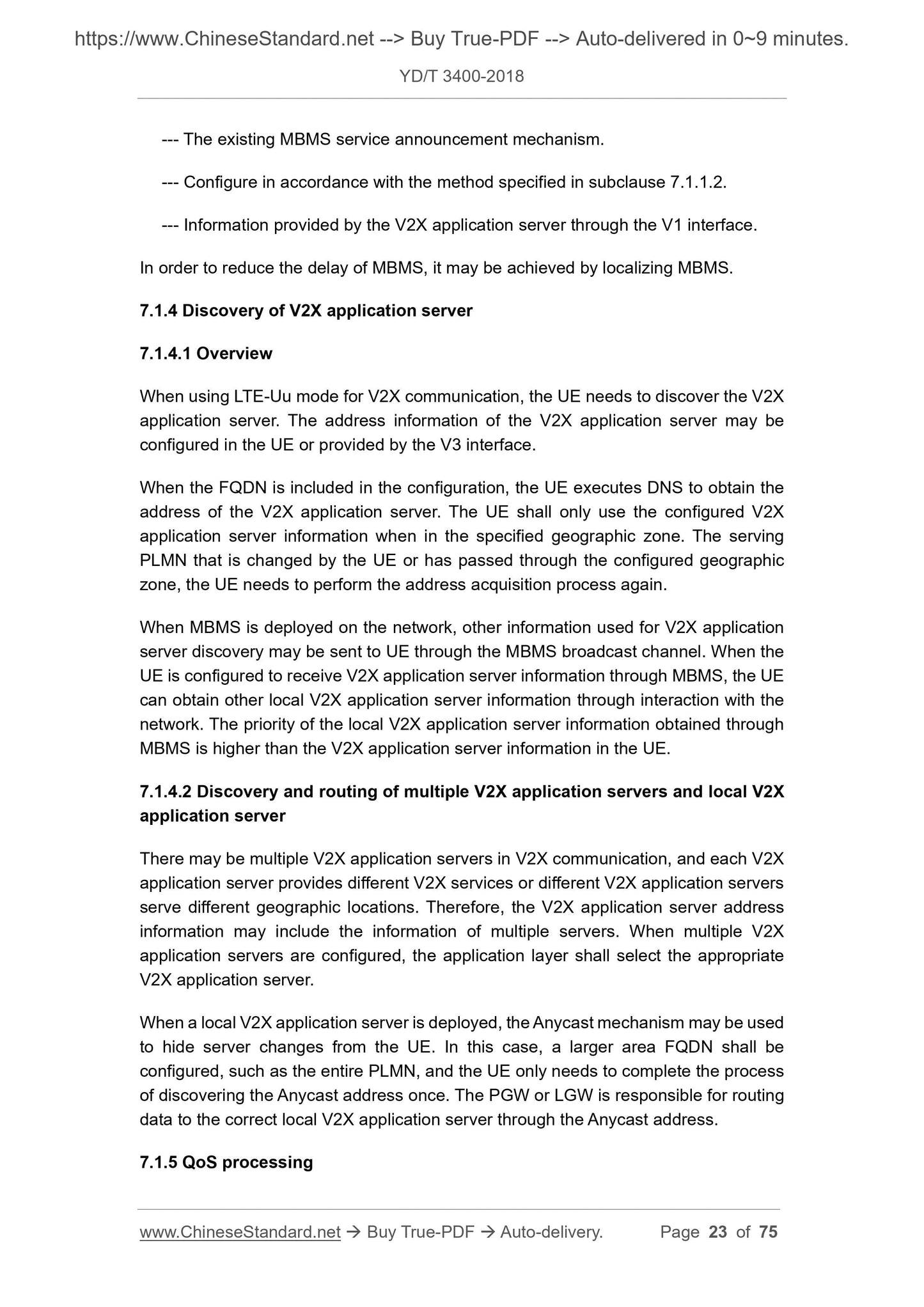PayPal, credit cards. Download editable-PDF and invoice in 1 second!
YD/T 3400-2018 English PDF (YDT3400-2018)
YD/T 3400-2018 English PDF (YDT3400-2018)
Precio habitual
$685.00 USD
Precio habitual
Precio de oferta
$685.00 USD
Precio unitario
/
por
Los gastos de envío se calculan en la pantalla de pago.
No se pudo cargar la disponibilidad de retiro
Delivery: 3 seconds. Download true-PDF + Invoice.
Get QUOTATION in 1-minute: Click YD/T 3400-2018
Historical versions: YD/T 3400-2018
Preview True-PDF (Reload/Scroll if blank)
YD/T 3400-2018: General technical requirements of LTE-basedvehicular communication
YD/T 3400-2018
YD
COMMUNICATION INDUSTRY STANDARD
OF THE PEOPLE’S REPUBLIC OF CHINA
ICS 33.060.99
M 36
General Technical Requirements of LTE-Based
Vehicular Communication
ISSUED ON: DECEMBER 21, 2018
IMPLEMENTED ON: APRIL 01, 2019
Issued by: Ministry of Industry and Information Technology of PRC
Table of Contents
Foreword ... 4
1 Scope ... 5
2 Normative References ... 5
3 Terms, Definitions and Abbreviations ... 5
3.1 Terms and Definitions ... 5
3.2 Abbreviations ... 6
4 Overview ... 7
5 General Service Requirements of LTE-Based Vehicle-to-Everything ... 7
5.1 Basic requirements ... 7
5.2 Effective communication distance ... 9
5.3 Movement speed ... 9
5.4 Communication delay ... 9
5.5 Transmission reliability ... 9
5.6 Requirements for information security ... 9
5.7 Requirements for coverage ... 10
5.8 Requirements for message sending frequency ... 10
5.9 Requirements for message size ... 10
6 Radio Communication System Architecture of LTE-Based Vehicle-to-
Everything ... 11
6.1 Architecture model ... 11
6.2 Introduction of the interface ... 14
6.3 Functional entities ... 15
7 Basic Functional Requirements of LTE-Based Vehicle-to-Everything ... 17
7.1 High-level functional requirements ... 18
7.2 Requirements of the radio function ... 27
7.3 Identification ... 33
7.4 Function description and message flow ... 34
Appendix A (Informative) Application Scenarios and Requirements of the LTE-
Based Vehicle-to-Everything ... 41
General Technical Requirements of LTE-Based
Vehicular Communication
1 Scope
This Standard specifies the overall service requirements, system architecture and
basic functional requirements of LTE-based vehicular communication.
This Standard is applicable to LTE-based vehicular communication systems.
2 Normative References
The following documents are essential to the application of this document. For the
dated documents, only the versions with the dates indicated are applicable to this
document; for the undated documents, only the latest version (including all the
amendments) is applicable to this document.
3GPP TS 23.246 Multimedia Broadcast/Multicast Service (MBMS) Architecture
and Functional Description
3GPP TS 23.303 Proximity-Based Service (ProSe); Stage 2
3GPP TS 23.401 General Packet Radio Service (GPRS) Enhancements for
Evolved Universal Terrestrial Radio Access Network (E-UTRAN) Access
3GPP TS 23.468 Group Communication System Enablers for LTE (GCSE_LTE);
Stage 2
3GPP TS 33.185 Security Aspect for LTE Support of V2X Services
3GPP TS 36.331 Evolved Universal Terrestrial Radio Access (E-UTRA) Radio
Resource Control (RRC); Protocol Specification
3 Terms, Definitions and Abbreviations
3.1 Terms and Definitions
For the purpose of this document, the following terms and definitions apply.
4 Overview
Vehicle-to-Everything (V2X) applications include Vehicle-to-Vehicle (V2V) applications,
Vehicle-to-Infrastructure (V2I) applications, Vehicle-to-Network (V2N) applications and
Vehicle-to-Pedestrian (V2P) applications.
V2V application refers to the exchange of V2V application information between
adjacent on-board UEs. The information exchange is based on the broadcast mode,
and the direct mode between UEs may be used, or information may be exchanged
between UEs through infrastructure [such as road side unit (RSU), application server].
V2I application refers to the on-board UE sends V2I application information to the RSU
or local application server; and the RSU or local application server sends the V2I
application information to the on-board UE.
V2N application refers to communication between UE and application server through
EPS network.
V2P application refers to the exchange of V2P application information between an on-
board UE and a human-held UE. Information exchange may adopt the direct mode
between UEs, or exchange information between UEs via infrastructure [such as road
side unit (RSU), application server].
The LTE-based vehicular communication system supports Vehicle-to-Vehicle (V2V)
applications, Vehicle-to-Infrastructure (V2I) applications, Vehicle-to-Network (V2N)
applications, and Vehicle-to-Pedestrian (V2P) applications. These applications may
provide users with various services such as road safety, traffic efficiency improvement
and infotainment, etc. Appendix A provides application scenarios and demand analysis
LTE-based Vehicle-to-Everything.
5 General Service Requirements of LTE-Based Vehicle-
to-Everything
5.1 Basic requirements
Requirement 1: When the sending terminal is served by E-UTRAN that supports V2X,
the message transmission shall be controlled by the 3GPP network.
Requirement 2: When the Vehicle-to-Everything terminal fails to be served by the E-
UTRAN network that supports V2X, it shall be able to support and use the 3GPP
network to pre-configure the system parameters for sending and receiving messages.
Requirement 3: Whether or not it is served by the E-UTRAN network that supports
5.2 Effective communication distance
Requirement 16: E-UTRA shall be able to provide sufficient effective communication
distance to ensure that the driver has sufficient response time (for instance, 4s).
5.3 Movement speed
Requirement 17: Regardless of whether the Vehicle-to-Everything terminal uses the
Vehicle-to-Everything communication service that is provided by E-UTRAN that
supports V2X communication, the 3GPP system shall be able to support messages
sending between vehicles at a maximum relative speed of 500km/h.
Requirement 18: Regardless of whether the Vehicle-to-Everything terminal or road
side unit or pedestrians use the Vehicle-to-Everything communication service that is
provided by E-UTRAN that supports V2X communication, the 3GPP system shall be
able to support the message sending between vehicles and vehicles at a maximum
absolute speed of 250km/h, between vehicles and road side units, as well as between
vehicles and pedestrians send messages.
5.4 Communication delay
Requirement 19: For terminals that support vehicle-to-vehicle and vehicle-to-
pedestrian communication, whether it is sent directly or forwarded by a road side unit,
E-UTRA (N) shall ensure that the maximum communication delay not exceed 100ms.
Requirement 20: Only for special use cases (such as collision detection), the maximum
delay of sending V2V messages between E-UTRA (N) Vehicle-to-Everything terminals
should not exceed 20ms.
Requirement 21: For vehicle-to-road side unit communication, the maximum
communication delay between the vehicle and the road side unit does not exceed
100ms.
Requirement 22: For the communication BETWEEN the Vehicle-to-Everything terminal
that supports the V2N service and goes through the 3GPP network entity AND the
application server, the maximum end-to-end delay shall not exceed 1000ms.
5.5 Transmission reliability
Requirement 23: The E-UTRAN network shall not rely on application layer
retransmission to provide highly reliable transmission.
5.6 Requirements for information security
Requirement 24: When the Vehicle-to-Everything terminal uses the service that is
provided by E-UTRAN that supports V2X communication, the 3GPP network shall
provide a method for the operator to authorize the Vehicle-to-Everything terminal to
characteristics (such as delay, message size), and does not pay attention to specific message
types.
6 Radio Communication System Architecture of LTE-
Ba...
Get QUOTATION in 1-minute: Click YD/T 3400-2018
Historical versions: YD/T 3400-2018
Preview True-PDF (Reload/Scroll if blank)
YD/T 3400-2018: General technical requirements of LTE-basedvehicular communication
YD/T 3400-2018
YD
COMMUNICATION INDUSTRY STANDARD
OF THE PEOPLE’S REPUBLIC OF CHINA
ICS 33.060.99
M 36
General Technical Requirements of LTE-Based
Vehicular Communication
ISSUED ON: DECEMBER 21, 2018
IMPLEMENTED ON: APRIL 01, 2019
Issued by: Ministry of Industry and Information Technology of PRC
Table of Contents
Foreword ... 4
1 Scope ... 5
2 Normative References ... 5
3 Terms, Definitions and Abbreviations ... 5
3.1 Terms and Definitions ... 5
3.2 Abbreviations ... 6
4 Overview ... 7
5 General Service Requirements of LTE-Based Vehicle-to-Everything ... 7
5.1 Basic requirements ... 7
5.2 Effective communication distance ... 9
5.3 Movement speed ... 9
5.4 Communication delay ... 9
5.5 Transmission reliability ... 9
5.6 Requirements for information security ... 9
5.7 Requirements for coverage ... 10
5.8 Requirements for message sending frequency ... 10
5.9 Requirements for message size ... 10
6 Radio Communication System Architecture of LTE-Based Vehicle-to-
Everything ... 11
6.1 Architecture model ... 11
6.2 Introduction of the interface ... 14
6.3 Functional entities ... 15
7 Basic Functional Requirements of LTE-Based Vehicle-to-Everything ... 17
7.1 High-level functional requirements ... 18
7.2 Requirements of the radio function ... 27
7.3 Identification ... 33
7.4 Function description and message flow ... 34
Appendix A (Informative) Application Scenarios and Requirements of the LTE-
Based Vehicle-to-Everything ... 41
General Technical Requirements of LTE-Based
Vehicular Communication
1 Scope
This Standard specifies the overall service requirements, system architecture and
basic functional requirements of LTE-based vehicular communication.
This Standard is applicable to LTE-based vehicular communication systems.
2 Normative References
The following documents are essential to the application of this document. For the
dated documents, only the versions with the dates indicated are applicable to this
document; for the undated documents, only the latest version (including all the
amendments) is applicable to this document.
3GPP TS 23.246 Multimedia Broadcast/Multicast Service (MBMS) Architecture
and Functional Description
3GPP TS 23.303 Proximity-Based Service (ProSe); Stage 2
3GPP TS 23.401 General Packet Radio Service (GPRS) Enhancements for
Evolved Universal Terrestrial Radio Access Network (E-UTRAN) Access
3GPP TS 23.468 Group Communication System Enablers for LTE (GCSE_LTE);
Stage 2
3GPP TS 33.185 Security Aspect for LTE Support of V2X Services
3GPP TS 36.331 Evolved Universal Terrestrial Radio Access (E-UTRA) Radio
Resource Control (RRC); Protocol Specification
3 Terms, Definitions and Abbreviations
3.1 Terms and Definitions
For the purpose of this document, the following terms and definitions apply.
4 Overview
Vehicle-to-Everything (V2X) applications include Vehicle-to-Vehicle (V2V) applications,
Vehicle-to-Infrastructure (V2I) applications, Vehicle-to-Network (V2N) applications and
Vehicle-to-Pedestrian (V2P) applications.
V2V application refers to the exchange of V2V application information between
adjacent on-board UEs. The information exchange is based on the broadcast mode,
and the direct mode between UEs may be used, or information may be exchanged
between UEs through infrastructure [such as road side unit (RSU), application server].
V2I application refers to the on-board UE sends V2I application information to the RSU
or local application server; and the RSU or local application server sends the V2I
application information to the on-board UE.
V2N application refers to communication between UE and application server through
EPS network.
V2P application refers to the exchange of V2P application information between an on-
board UE and a human-held UE. Information exchange may adopt the direct mode
between UEs, or exchange information between UEs via infrastructure [such as road
side unit (RSU), application server].
The LTE-based vehicular communication system supports Vehicle-to-Vehicle (V2V)
applications, Vehicle-to-Infrastructure (V2I) applications, Vehicle-to-Network (V2N)
applications, and Vehicle-to-Pedestrian (V2P) applications. These applications may
provide users with various services such as road safety, traffic efficiency improvement
and infotainment, etc. Appendix A provides application scenarios and demand analysis
LTE-based Vehicle-to-Everything.
5 General Service Requirements of LTE-Based Vehicle-
to-Everything
5.1 Basic requirements
Requirement 1: When the sending terminal is served by E-UTRAN that supports V2X,
the message transmission shall be controlled by the 3GPP network.
Requirement 2: When the Vehicle-to-Everything terminal fails to be served by the E-
UTRAN network that supports V2X, it shall be able to support and use the 3GPP
network to pre-configure the system parameters for sending and receiving messages.
Requirement 3: Whether or not it is served by the E-UTRAN network that supports
5.2 Effective communication distance
Requirement 16: E-UTRA shall be able to provide sufficient effective communication
distance to ensure that the driver has sufficient response time (for instance, 4s).
5.3 Movement speed
Requirement 17: Regardless of whether the Vehicle-to-Everything terminal uses the
Vehicle-to-Everything communication service that is provided by E-UTRAN that
supports V2X communication, the 3GPP system shall be able to support messages
sending between vehicles at a maximum relative speed of 500km/h.
Requirement 18: Regardless of whether the Vehicle-to-Everything terminal or road
side unit or pedestrians use the Vehicle-to-Everything communication service that is
provided by E-UTRAN that supports V2X communication, the 3GPP system shall be
able to support the message sending between vehicles and vehicles at a maximum
absolute speed of 250km/h, between vehicles and road side units, as well as between
vehicles and pedestrians send messages.
5.4 Communication delay
Requirement 19: For terminals that support vehicle-to-vehicle and vehicle-to-
pedestrian communication, whether it is sent directly or forwarded by a road side unit,
E-UTRA (N) shall ensure that the maximum communication delay not exceed 100ms.
Requirement 20: Only for special use cases (such as collision detection), the maximum
delay of sending V2V messages between E-UTRA (N) Vehicle-to-Everything terminals
should not exceed 20ms.
Requirement 21: For vehicle-to-road side unit communication, the maximum
communication delay between the vehicle and the road side unit does not exceed
100ms.
Requirement 22: For the communication BETWEEN the Vehicle-to-Everything terminal
that supports the V2N service and goes through the 3GPP network entity AND the
application server, the maximum end-to-end delay shall not exceed 1000ms.
5.5 Transmission reliability
Requirement 23: The E-UTRAN network shall not rely on application layer
retransmission to provide highly reliable transmission.
5.6 Requirements for information security
Requirement 24: When the Vehicle-to-Everything terminal uses the service that is
provided by E-UTRAN that supports V2X communication, the 3GPP network shall
provide a method for the operator to authorize the Vehicle-to-Everything terminal to
characteristics (such as delay, message size), and does not pay attention to specific message
types.
6 Radio Communication System Architecture of LTE-
Ba...
Share
